Effect of Filtered Back-Projection Filters to Low-Contrast Object Imaging in Ultra-High-Resolution (UHR) Cone-Beam Computed Tomography (CBCT)
Abstract
1. Introduction
2. Materials and Methods
2.1. Ultra-High-Resolution Cone-Beam Computed Tomography System and Imaging Configurations
2.2. CT Performance Phantom
2.3. Ramp Filter Design in Spatial Domain and Six Different Window Functions
2.4. Modulation Transfer Function (MTF)
2.5. Normalized Noise Power Spectrum
3. Results
3.1. Filter Shape
3.2. Reconstructed Images with Different Filters and Configurations
3.3. Modulation Transfer Function
3.4. Normalized Noise Power Spectrum
4. Discussion
5. Conclusions
Author Contributions
Funding
Acknowledgments
Conflicts of Interest
References
- Yoshioka, K.; Tanaka, R.; Takagi, H.; Ueyama, Y.; Kikuchi, K.; Chiba, T.; Arakita, K.; Schuijf, J.D.; Saito, Y. Ultra-high-resolution CT angiography of the artery of Adamkiewicz: A feasibility study. Neuroradiology 2018, 60, 109–115. [Google Scholar] [CrossRef] [PubMed]
- Kakinuma, R.; Moriyama, N.; Muramatsu, Y.; Gomi, S.; Suzuki, M.; Nagasawa, H.; Kusumoto, M.; Aso, T.; Muramatsu, Y.; Tsuchida, T.; et al. Ultra-High-Resolution Computed Tomography of the Lung: Image Quality of a Prototype Scanner. PLoS ONE 2015, 10, e0137165. [Google Scholar] [CrossRef] [PubMed]
- Akagi, M.; Nakamura, Y.; Higaki, T.; Narita, K.; Honda, Y.; Zhou, J.; Yu, Z.; Akino, N.; Awai, K. Deep learning reconstruction improves image quality of abdominal ultra-high-resolution CT. Eur. Radiol. 2019, 29, 6163–6171. [Google Scholar] [CrossRef] [PubMed]
- Hata, A.; Yanagawa, M.; Honda, O.; Kikuchi, N.; Miyata, T.; Tsukagoshi, S.; Uranishi, A.; Tomiyama, N. Effect of matrix size on the image quality of ultra-high-resolution CT of the lung: Comparison of 512 × 512, 1024 × 1024, and 2048 × 2048. Acad. Radiol. 2018, 25, 869–876. [Google Scholar] [CrossRef] [PubMed]
- Yanagawa, M.; Tomiyama, N.; Honda, O.; Kikuyama, A.; Sumikawa, H.; Inoue, A.; Tobino, K.; Koyama, M.; Kudo, M. Multidetector CT of the lung: Image quality with garnet-based detectors. Radiology 2010, 255, 944–954. [Google Scholar] [CrossRef] [PubMed]
- Tsukagoshi, S.; Ota, T.; Fujii, M.; Kazama, M.; Okumura, M.; Johkoh, T. Improvement of spatial resolution in the longitudinal direction for isotropic imaging in helical CT. Phys. Med. Biol. 2007, 52, 791–801. [Google Scholar] [CrossRef]
- Heutink, F.; Koch, V.; Verbist, B.; van der Woude, W.J.; Mylanus, E.; Huinck, W.; Sechopoulos, I.; Caballo, M. Multi-Scale deep learning framework for cochlea localization, segmentation and analysis on clinical ultra-high-resolution CT images. Comput. Meth. Prog. Biomed. 2020, 191, 105387. [Google Scholar] [CrossRef]
- Oostveen, L.J.; Boedeker, K.L.; Brink, M.; Prokop, M.; De Lange, F.; Sechopoulos, I. Physical evaluation of an ultra-high-resolution CT scanner. Eur. Radiol. 2020, 30, 2552–2560. [Google Scholar] [CrossRef]
- Gupta, R.; Grasruck, M.; Suess, C.; Bartling, S.H.; Schmidt, B.; Stierstorfer, K.; Popescu, S.; Brady, T.; Flohr, T. Ultra-high resolution flat-panel volume CT: Fundamental principles, design architecture, and system characterization. Eur. Radiol. 2006, 16, 1191–1205. [Google Scholar] [CrossRef]
- Sisniega, A.; Thawait, G.K.; Shakoor, D.; Siewerdsen, J.H.; Demehri, S.; Zbijewski, W. Motion compensation in extremity cone-beam computed tomography. Skelet. Radiol. 2019, 48, 1999–2007. [Google Scholar] [CrossRef]
- Cao, Q.; Sisniega, A.; Brehler, M.; Stayman, J.W.; Yorkston, J.; Siewerdsen, J.H.; Zbijewski, W. Modeling and evaluation of a high-resolution CMOS detector for cone-beam CT of the extremities. Med. Phys. 2018, 45, 114–130. [Google Scholar] [CrossRef] [PubMed]
- Zhao, B.; Zhao, W. Imaging performance of an amorphous selenium digital mammography detector in a breast tomosynthesis system. Med. Phys. 2008, 35, 1978–1987. [Google Scholar] [CrossRef] [PubMed]
- Euler, A.; Solomon, J.B.; Marin, D.; Nelson, R.C.; Samei, E. A third-generation adaptive statistical iterative reconstruction technique: Phantom study of image noise, spatial resolution, lesion detectability, and dose reduction potential. Am. J. Roentgenol. 2018, 210, 1301–1308. [Google Scholar] [CrossRef] [PubMed]
- Gang, G.J.; Tward, D.J.; Lee, J.; Siewerdsen, J.H. Anatomical background and generalized detectability in tomosynthesis and cone-beam CT. Med. Phys. 2010, 37, 1948–1965. [Google Scholar] [CrossRef] [PubMed]
- Pauwels, R.; Araki, K.; Siewerdsen, J.H.; Thongvigitmanee, S.S. Technical aspects of dental CBCT: State of the art. Dentomaxillofac. Rad. 2015, 44, 20140224. [Google Scholar] [CrossRef] [PubMed]
- Richard, S.; Siewerdsen, J.H. Comparison of model and human observer performance for detection and discrimination tasks using dual-energy X-ray images. Med. Phys. 2008, 35, 5043–5053. [Google Scholar] [CrossRef]
- Zeng, G.L. Revisit of the ramp filter. In Proceedings of the 2014 IEEE Nuclear Science Symposium and Medical Imaging Conference (NSS/MIC), Seattle, WA, USA, 8–15 November 2014. [Google Scholar]
- Srinivasan, K.; Mohammadi, M.; Shepherd, J. Investigation of effect of reconstruction filters on cone-beam computed tomography image quality. Australas. Phys. Eng. Sci. Med. 2014, 37, 607–614. [Google Scholar] [CrossRef]
- Richard, S.; Husarik, D.B.; Yadava, G.; Murphy, S.N.; Samei, E. Towards task-based assessment of CT performance: System and object MTF across different reconstruction algorithms. Med. Phys. 2012, 39, 4115–4122. [Google Scholar] [CrossRef]
- Choi, S.; Lee, H.; Lee, D.; Choi, S.; Lee, C.-L.; Kwon, W.; Shin, J.; Seo, C.-W.; Kim, H.-J. Development of a chest digital tomosynthesis R/F system and implementation of low-dose GPU-accelerated compressed sensing (CS) image reconstruction. Med. Phys. 2018, 45, 1871–1888. [Google Scholar] [CrossRef]
- Gang, G.J.; Lee, J.; Stayman, J.W.; Tward, D.J.; Zbijewski, W.; Prince, J.L.; Siewerdsen, J.H. Analysis of Fourier-domain task-based detectability index in tomosynthesis and cone-beam CT in relation to human observer performance. Med. Phys. 2011, 38, 1754–1768. [Google Scholar] [CrossRef]
- Gang, G.J.; Zbijewski, W.; Stayman, J.W.; Siewerdsen, J.H. Cascaded systems analysis of noise and detectability in dual-energy cone-beam CT. Med. Phys. 2012, 39, 5145–5156. [Google Scholar] [CrossRef] [PubMed]
- Prakash, P.; Zbijewski, W.; Gang, G.J.; Ding, Y.; Stayman, J.W.; Yorkston, J.; Carrino, J.A.; Siewerdsen, J.H. Task-based modeling and optimization of a cone-beam CT scanner for musculoskeletal imaging. Med. Phys. 2011, 38, 5612–5629. [Google Scholar] [CrossRef]
- Leong, L.K.; Kruger, R.L.; O’Connor, M.K. A comparison of the uniformity requirements for SPECT image reconstruction using FBP and OSEM techniques. J. Nucl. Med. Technol. 2001, 29, 79–83. [Google Scholar] [PubMed]
- Reljin, I.; Reljin, B.; Papic, V.D. Extremely flat-top windows for harmonic analysis. IEEE Trans. Instrum. Meas. 2007, 56, 1025–1041. [Google Scholar] [CrossRef]
- Gilland, D.R.; Tsui, B.M.; McCartney, W.H.; Perry, J.R.; Berg, J. Determination of the optimum filter function for SPECT imaging. J. Nucl. Med. 1988, 29, 643–650. [Google Scholar] [PubMed]
- Gade, S.; Herlufsen, H. Use of Weighting Functions in DFT/FFT analysis. In Windows to FFT Analysis; Brüel & Kjær Technical Review No. 3; Brüel & Kjær: Nærum, Denmark, 1987. [Google Scholar]
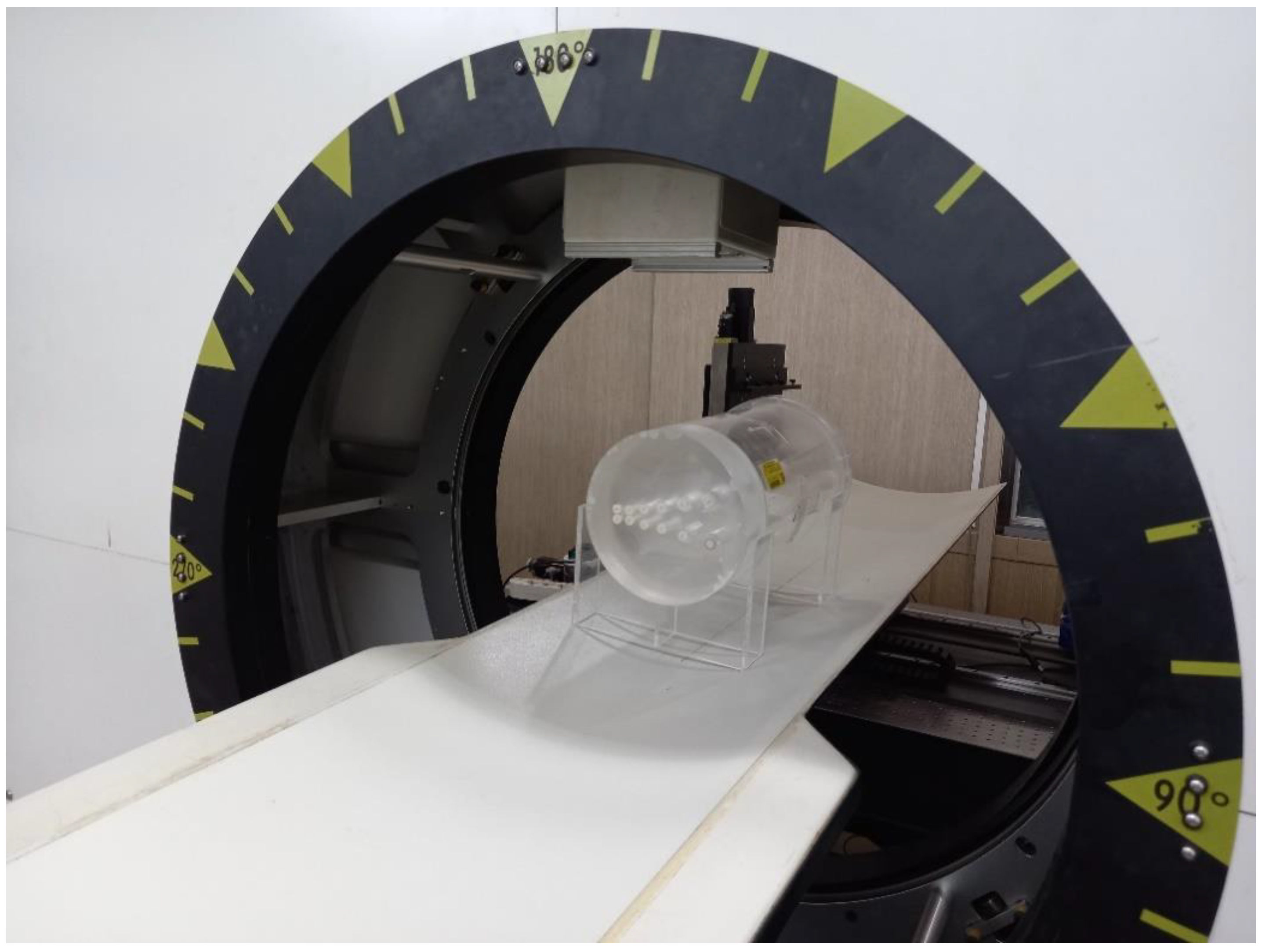
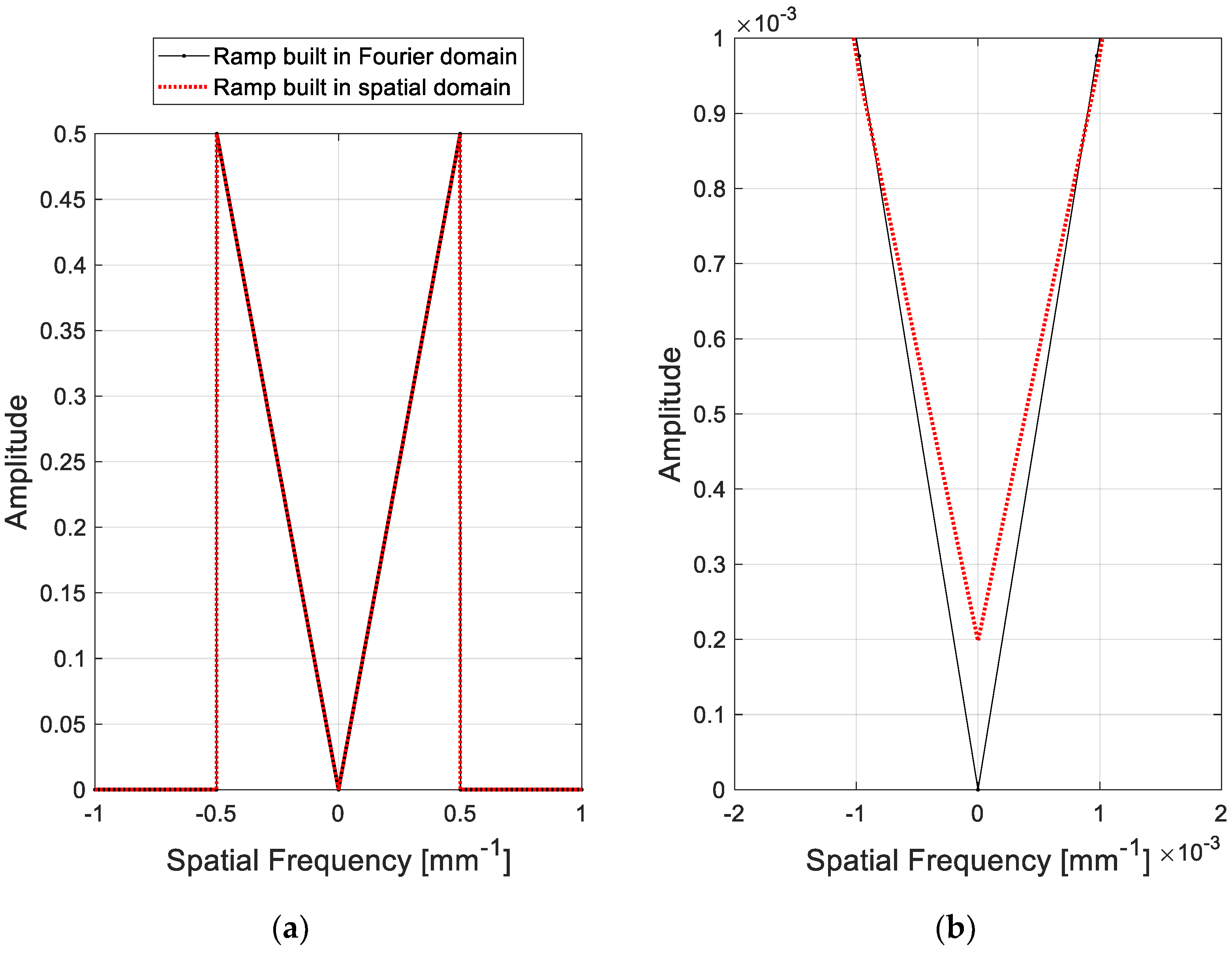




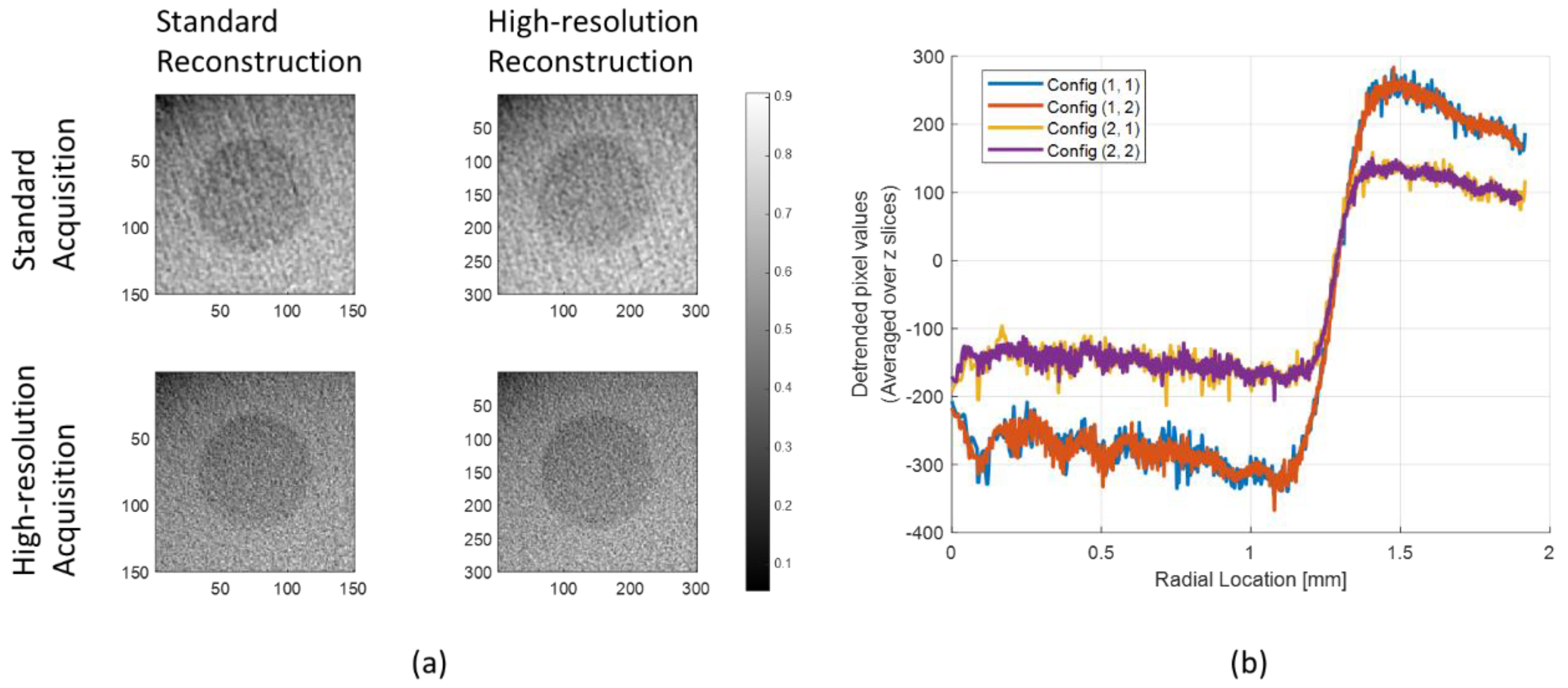


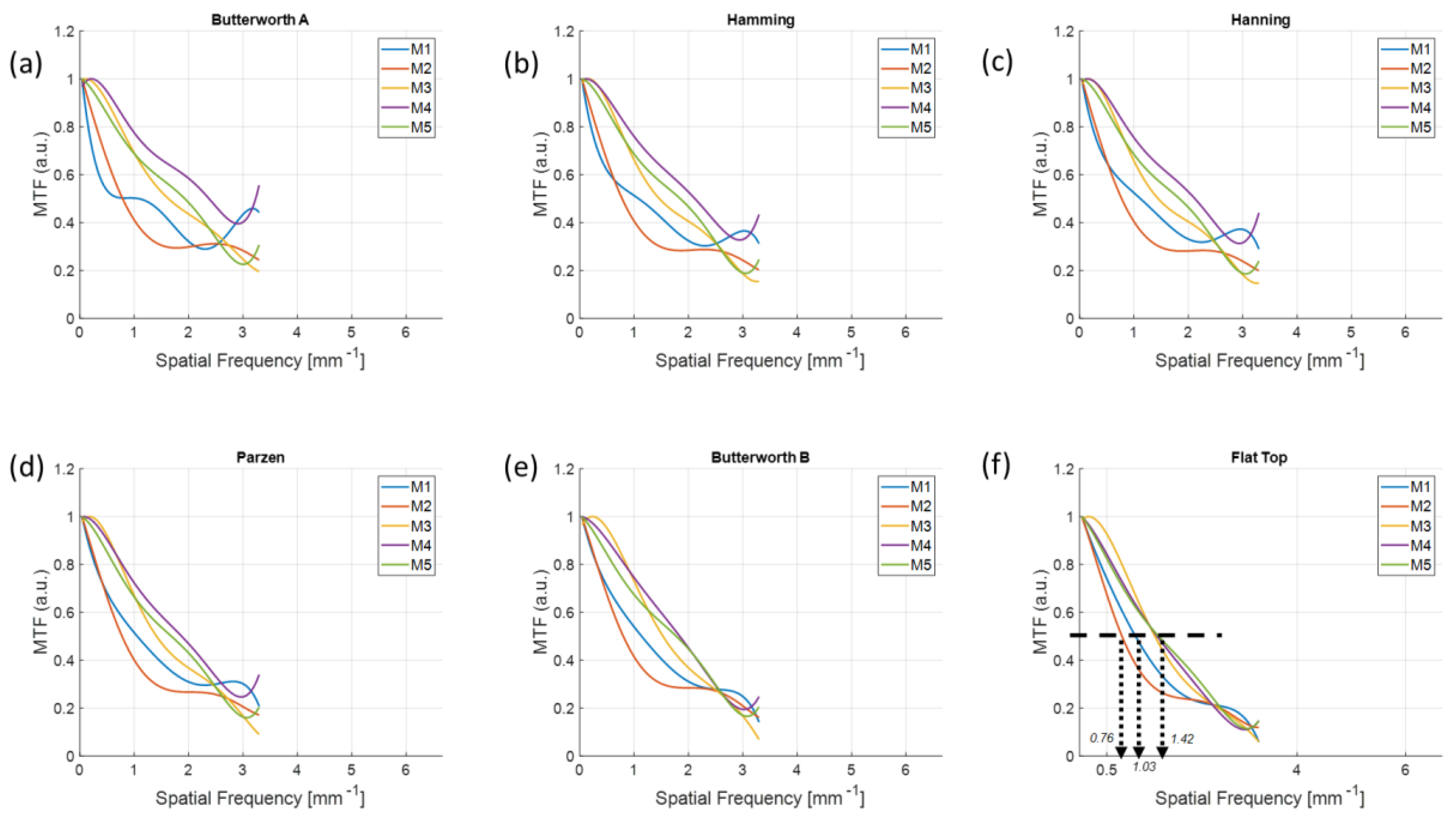
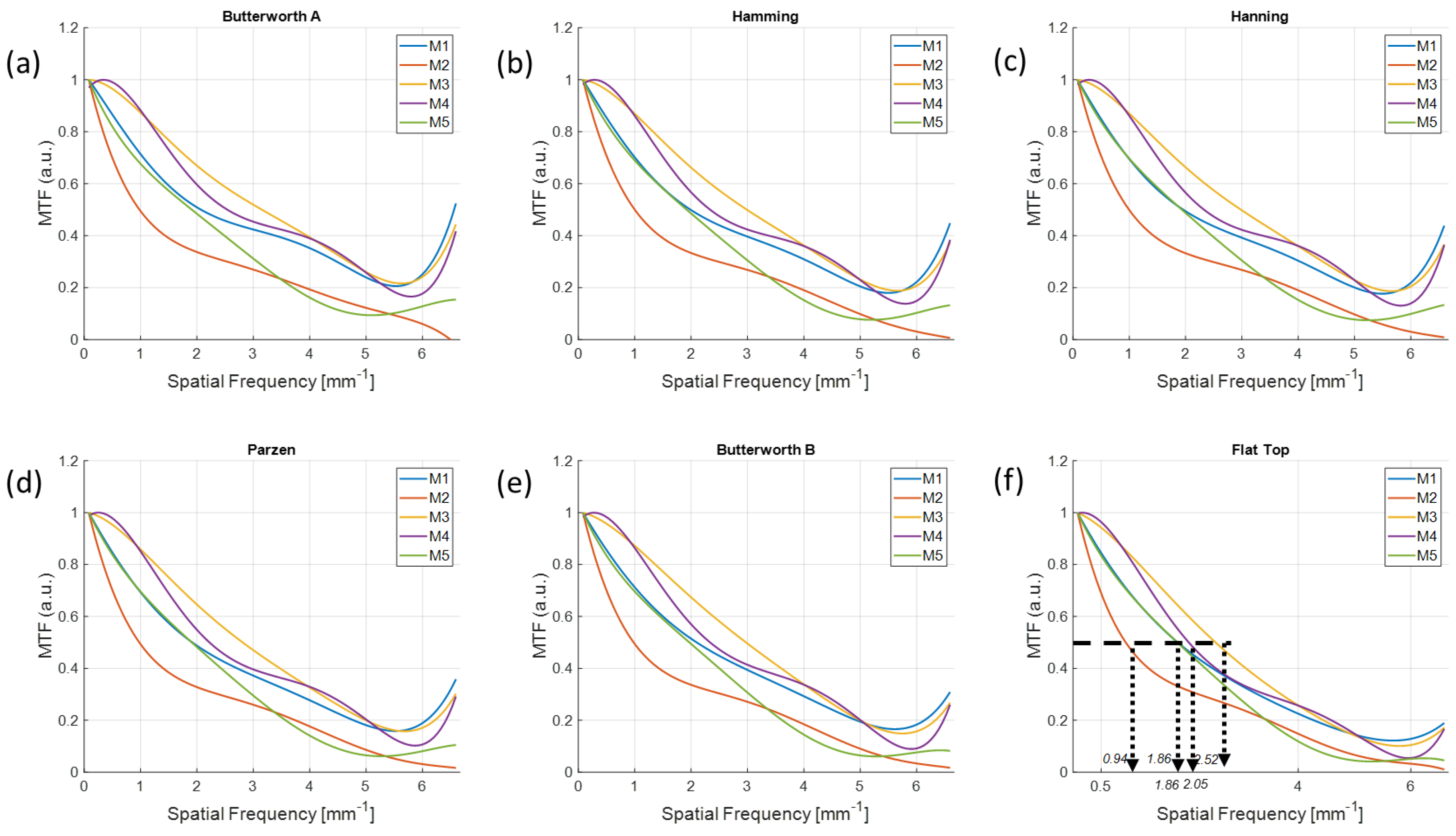
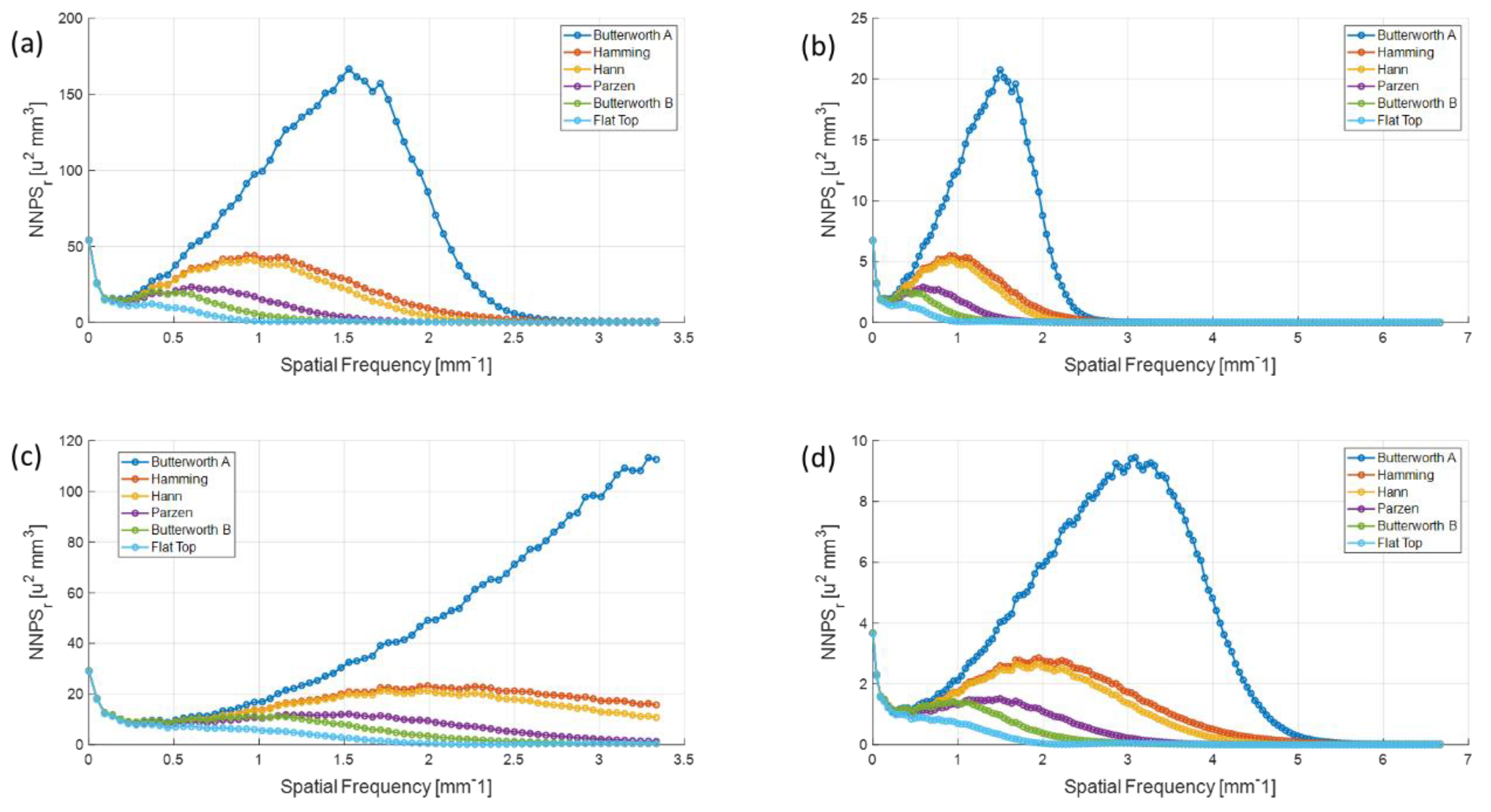
| Gantry | Sweep angle | 0° to 360° with 1° step | |
| Source-to-detector distance | 1330 mm | ||
| Isocenter-to-detector distance | 660 mm | ||
| X-ray tube | Tube voltage | 40–120 kVp | |
| Tube current | 10–500 mA | ||
| Exposure duration | 16 ms | ||
| FPD | Standard acquisition | UHR acquisition | |
| Image matrix | 1024 × 768 | 2048 × 1536 | |
| Pixel interval | 0.388 mm | 0.194 mm | |
| Framerate | 7.5 fps | 30 fps | |
| Readout time per view | ~55 ms | ~220 ms | |
| Total acquisition time | 24 s | 48 s | |
| Total entrance surface dose (ESD) | 2.82 mGy | 11.3 mGy | |
| Reconstruction | Standard reconstruction | UHR reconstruction | |
| Image matrix | 512 × 512 | 1024 × 1024 | |
| Pixel interval | 0.3 mm | 0.15 mm | |
| Standard Reconstruction | UHR Reconstruction | |
|---|---|---|
| Standard acquisition | Configuration (1, 1) | Configuration (1, 2) |
| UHR acquisition | Configuration (2, 1) | Configuration (2, 2) |
| Material Index | Material Name (Density (g/cc)) |
|---|---|
| M1 | Polyethylene (0.95) |
| M2 | Polystyrene (1.05) |
| M3 | Nylon (1.10) |
| M4 | Acrylic (1.19) |
| M5 | Polycarbonate (1.20) |
| Background | PMMA * (1.18) |
| Window Title | Equation |
|---|---|
| (a) Butterworth A 1 | if |
| (b) Hanning | if |
| (c) Hamming | if |
| (d) Parzen | |
| (e) Butterworth B 2 | |
| (f) Flat Top |
Publisher’s Note: MDPI stays neutral with regard to jurisdictional claims in published maps and institutional affiliations. |
© 2020 by the authors. Licensee MDPI, Basel, Switzerland. This article is an open access article distributed under the terms and conditions of the Creative Commons Attribution (CC BY) license (http://creativecommons.org/licenses/by/4.0/).
Share and Cite
Choi, S.; Seo, C.-W.; Cha, B.K. Effect of Filtered Back-Projection Filters to Low-Contrast Object Imaging in Ultra-High-Resolution (UHR) Cone-Beam Computed Tomography (CBCT). Sensors 2020, 20, 6416. https://doi.org/10.3390/s20226416
Choi S, Seo C-W, Cha BK. Effect of Filtered Back-Projection Filters to Low-Contrast Object Imaging in Ultra-High-Resolution (UHR) Cone-Beam Computed Tomography (CBCT). Sensors. 2020; 20(22):6416. https://doi.org/10.3390/s20226416
Chicago/Turabian StyleChoi, Sunghoon, Chang-Woo Seo, and Bo Kyung Cha. 2020. "Effect of Filtered Back-Projection Filters to Low-Contrast Object Imaging in Ultra-High-Resolution (UHR) Cone-Beam Computed Tomography (CBCT)" Sensors 20, no. 22: 6416. https://doi.org/10.3390/s20226416
APA StyleChoi, S., Seo, C.-W., & Cha, B. K. (2020). Effect of Filtered Back-Projection Filters to Low-Contrast Object Imaging in Ultra-High-Resolution (UHR) Cone-Beam Computed Tomography (CBCT). Sensors, 20(22), 6416. https://doi.org/10.3390/s20226416




